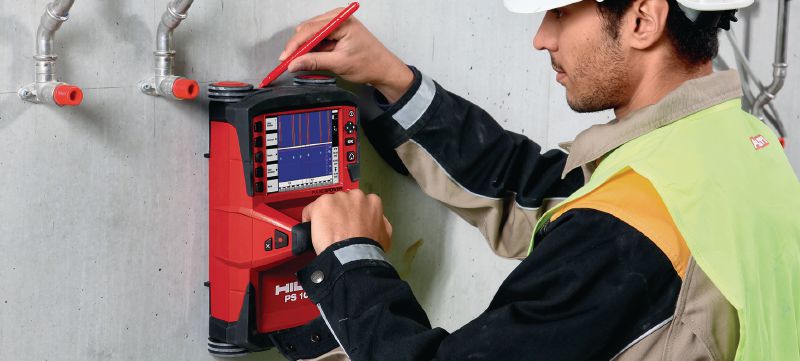RainierGPR Service Areas: Comprehensive Coverage for Concrete Scanning
RainierGPR Service Areas: Comprehensive Coverage for Concrete Scanning
Blog Article
Enhancing Project Planning and Execution Via Advanced Concrete Scanning Strategies
In the world of project planning and foresight, execution and precision are essential components that can make the difference in between success and setbacks. Advanced concrete scanning strategies have actually emerged as a sophisticated tool established to boost the requirements of project administration within the construction market.
Advantages of Advanced Concrete Scanning Strategies

Improved Accuracy in Task Assessments
Enhancing task assessments with innovative concrete scanning methods substantially improves the precision and reliability of building and construction examinations. By using innovative scanning innovations such as ground-penetrating radar (GPR) and 3D imaging, project teams can currently obtain detailed insights into the problem of concrete structures, determining potential imperfections or weaknesses that may not show up to the naked eye. This improved degree of precision in project assessments makes it possible for building and construction specialists to make even more educated choices concerning fixing and upkeep techniques, causing boosted total task end results.
Additionally, the increased accuracy in task assessments attained via advanced concrete scanning methods helps in reducing the threat of unanticipated problems throughout the construction phase. By proactively spotting surprise abnormalities within concrete structures, such as rebar rust or spaces, project groups can attend to these issues early, preventing costly hold-ups and remodel later in the task lifecycle. Inevitably, the enhanced precision in project evaluations helped with by sophisticated concrete scanning techniques adds to better effectiveness, cost-effectiveness, and top quality in building and construction projects.
Very Early Identification of Architectural Obstacles
Very early discovery of architectural difficulties plays a vital role in ensuring the integrity and safety and security of concrete frameworks throughout the building procedure. Recognizing prospective issues at an onset permits timely treatment, preventing expensive rework, schedule hold-ups, and safety and security risks. Advanced concrete scanning techniques, such as ground-penetrating radar (GPR) and 3D imaging, enable project groups to discover surprise problems, gaps, support design discrepancies, and various other anomalies that can compromise the structure's stability.
By executing these methods during the planning and execution phases, construction specialists can proactively address architectural obstacles before they rise into significant issues. As an example, spotting poor concrete cover over additional info support bars at an early stage can stop deterioration and architectural weakening in the lengthy run - RainierGPR Service Areas. Moreover, identifying variations in concrete thickness or thickness can assist enhance material usage and make sure uniform stamina residential properties across the framework

Ultimately, very early identification of architectural obstacles via innovative concrete scanning not just boosts the overall high quality and longevity of the building but additionally adds to a more secure built atmosphere for passengers and individuals.
Improved Precaution in Building And Construction
The execution of robust safety methods is imperative in the building industry to alleviate risks and guard the well-being of workers and stakeholders. Building and construction sites are naturally dangerous atmospheres, with possible threats ranging official website from drops and devices breakdowns to structural failings. To improve security steps, building companies are progressively adopting technical innovations such as wearable devices that check workers' essential signs and find potential health and wellness problems in real-time. Furthermore, the usage of drones for website monitoring enables routine safety assessments without placing personnel in harm's way. Safety training programs have additionally advanced to include virtual reality simulations that give hands-on experience in dealing with emergency circumstances. Furthermore, the integration of artificial intelligence in safety management systems enables positive recognition of possible dangers, allowing for prompt interventions. By focusing on safety with the unification of advanced innovations and detailed training programs, construction tasks can significantly reduce crashes and create a safe workplace for all included - RainierGPR Service Areas.
Streamlining Task Administration Processes
To maximize functional performance and ensure job success in the building industry, a concentrate on streamlining task administration processes is vital. By applying efficient job administration procedures, building projects can reduce hold-ups, decrease costs, and boost total performance. One vital aspect of simplifying task administration is making use of sophisticated technologies such as Structure Details Modeling (BIM) software, which allows real-time partnership, clash detection, and accurate project organizing. In addition, sites the adoption of cloud-based project monitoring platforms permits seamless communication amongst staff member, immediate access to task data, and the capacity to track progression in real-time.

Final Thought
Finally, the usage of innovative concrete scanning methods offers various benefits for task preparation and execution. These techniques give improved accuracy in task analyses, early identification of architectural difficulties, boosted safety actions in construction, and structured project management procedures. Including these approaches into job workflows can eventually cause much more successful and reliable outcomes in building and construction jobs.
Eventually, the enhanced accuracy in job analyses promoted by sophisticated concrete scanning strategies adds to better performance, cost-effectiveness, and top quality in building jobs. RainierGPR Service Areas.
To maximize functional effectiveness and guarantee job success in the construction sector, a focus on enhancing project management procedures is important. By executing efficient task administration processes, building tasks can minimize delays, reduce costs, and enhance overall performance. By enhancing project management processes via modern technology assimilation, clear interaction, and data-driven strategies, building tasks can attain higher efficiency, cost-effectiveness, and successful results.
These techniques supply enhanced accuracy in task assessments, early identification of architectural difficulties, improved safety steps in building and construction, and structured project administration processes.
Report this page